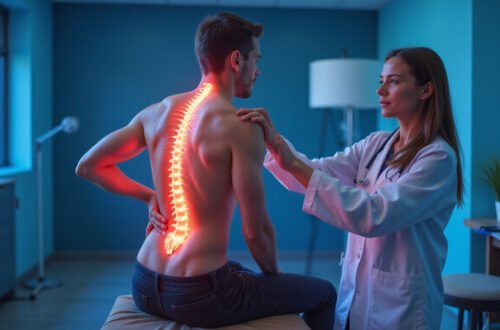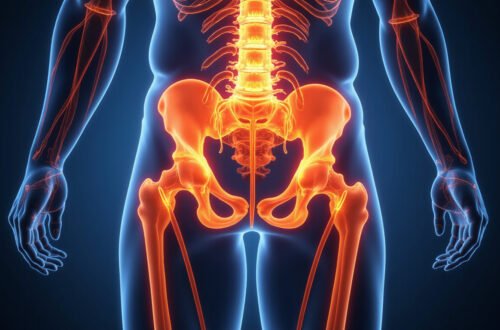Lumbar radiculopathy is a condition that affects many individuals, especially those experiencing lower back pain radiating down the leg. If you’ve ever wondered what causes this condition or how it can be managed, you’re not alone. In this comprehensive guide, we will explore lumbar radiculopathy in detail, shedding light on its causes, symptoms, and the myriad treatment options available. Whether you’re a patient seeking clarity or a healthcare professional refreshing your knowledge, this article aims to provide valuable insights into this common but often misunderstood condition.
What Is Lumbar Radiculopathy?
Lumbar radiculopathy refers to a condition where one or more nerve roots in the lumbar spine (lower back) become irritated or compressed. This nerve compression leads to pain, numbness, tingling, or weakness that radiates from the lower back into the legs or feet. It is often called a “pinched nerve” but is more accurately described as nerve root compression stemming from underlying spinal issues.
The lumbar region of the spine comprises five vertebrae—L1 through L5—that are interconnected by discs, facet joints, and ligaments. When any structure within or around these vertebrae impinges on a nerve root, symptoms of lumbar radiculopathy can manifest.
Causes of Lumbar Radiculopathy
Understanding the causes of lumbar radiculopathy is crucial for effective management and prevention. Several factors can contribute to nerve root compression in the lumbar spine, including:
-
Herniated Discs
The most common cause of lumbar radiculopathy is a herniated or slipped disc. When the soft inner core of a spinal disc protrudes through the tougher outer layer, it can press against adjacent nerve roots, causing inflammation and discomfort. -
Spinal Stenosis
This condition involves narrowing of the spinal canal, which can compress nerve roots. Spinal stenosis often occurs due to degeneration of spinal structures with age, leading to symptoms similar to lumbar radiculopathy. -
Degenerative Disc Disease
As discs deteriorate over time, they lose height and elasticity, leading to instability and nerve impingement. -
Bone Spurs and Osteoarthritis
Degenerative joint changes can produce bony growths known as osteophytes or bone spurs, which may compress nerve roots. -
Injury or Trauma
Fractures, falls, or accidents that impact the lumbar spine can result in nerve compression. -
Tumors or Infections
Less commonly, abnormal growths or infections within or near the spinal canal can cause nerve root compression.
Symptoms of Lumbar Radiculopathy
Symptoms can vary depending on the nerve root involved and the severity of compression. Common signs include:
- Lower back pain that may radiate into the buttocks, thigh, calf, or foot
- Tingling or “pins and needles” sensations in the leg or foot
- Numbness or loss of sensation in affected areas
- Muscle weakness in the leg or foot
- Difficulty walking or standing for extended periods
- A burning sensation along nerve pathways
- Reduced reflexes in the lower limbs
It’s essential to recognize that not all cases produce significant symptoms, and some individuals may experience mild discomfort, while others have debilitating pain and weakness.
Diagnosis of Lumbar Radiculopathy
Diagnosing lumbar radiculopathy typically involves a combination of clinical evaluation and imaging studies. Healthcare providers may perform physical exams to assess reflexes, muscle strength, and sensory function. Imaging tools such as magnetic resonance imaging (MRI) are the gold standard for visualizing soft tissues, discs, and nerve structures, helping identify herniated discs or spinal narrowing.

In some cases, nerve conduction studies or electromyography (EMG) are used to evaluate nerve function and pinpoint affected nerve roots.
Treatment Options for Lumbar Radiculopathy
Management strategies for lumbar radiculopathy aim to alleviate pain, reduce nerve inflammation, and restore normal function. Treatment options range from conservative to surgical interventions, depending on severity.
Conservative Treatments
Most cases of lumbar radiculopathy respond well to non-invasive methods, including:
-
Rest and Activity Modification
Reducing activities that exacerbate symptoms can help ease nerve irritation. -
Physical Therapy
Targeted exercises can strengthen core muscles, improve flexibility, and reduce pressure on nerve roots. -
Medications
- Nonsteroidal anti-inflammatory drugs (NSAIDs) to reduce inflammation and pain
- Muscle relaxants to ease muscle spasms
- Neuropathic pain agents such as gabapentin or pregabalin
-
Heat and Cold Therapy
Applying heat packs or cold compresses can help reduce inflammation and muscle tension. -
Epidural Steroid Injections
For more persistent pain, corticosteroid injections around the nerve roots may provide relief by decreasing inflammation.
Surgical Treatments
When conservative measures fail or neurological deficits worsen, surgical intervention may be necessary. Common surgical procedures include:
-
Discectomy or Microdiscectomy
Removal of herniated disc material to decompress nerve roots -
Lumbar Laminectomy
Removing part of the vertebra (lamina) to widen the spinal canal -
Spinal Fusion
Stabilizing segments of the spine with bone grafts and hardware in cases of instability
Each case requires individual assessment, and surgical risks and benefits should be thoroughly discussed with a spinal specialist.
Preventive Measures and Outlook
While some causes of lumbar radiculopathy, such as degenerative disc disease, are age-related and inevitable, certain habits can reduce risk:
- Maintain good posture
- Engage in regular physical activity
- Practice proper lifting techniques
- Maintain a healthy weight
- Stay flexible and strengthen core muscles
The outlook for lumbar radiculopathy varies. Many individuals experience significant improvement with conservative treatment, while others may require surgical intervention. Advances in minimally invasive spine surgery continue to improve recovery times and outcomes.
Frequently Asked Questions (FAQs)
Q1: What is lumbar radiculopathy, and how is it different from general lower back pain?
A1: Lumbar radiculopathy specifically involves nerve root compression in the lower back, causing radiating pain, numbness, or weakness into the legs, whereas general lower back pain may be localized and unrelated to nerve root involvement.
Q2: Can lumbar radiculopathy resolve on its own?
A2: Mild cases often improve with conservative treatments such as physical therapy and medications. However, persistent or worsening symptoms may require medical or surgical intervention.
Q3: Are there any natural remedies effective for lumbar radiculopathy?
A3: Natural approaches like stretching, yoga, and maintaining good posture can support recovery, but they should complement, not replace, medical advice, especially if symptoms are severe.
External Source Citation
According to the American Academy of Orthopaedic Surgeons (AAOS), proper diagnosis and tailored treatment are essential for managing lumbar radiculopathy effectively (source).
Conclusion: Take Action Toward Recovery
If you’re experiencing symptoms consistent with lumbar radiculopathy, early diagnosis and appropriate treatment are key to preventing long-term complications. Whether through conservative management or surgical options, effective relief is attainable. Don’t ignore persistent lower back and leg pain—consult with a healthcare professional to develop a personalized plan that will help you regain comfort and mobility. Take proactive steps today and prioritize your spinal health—your future self will thank you.






